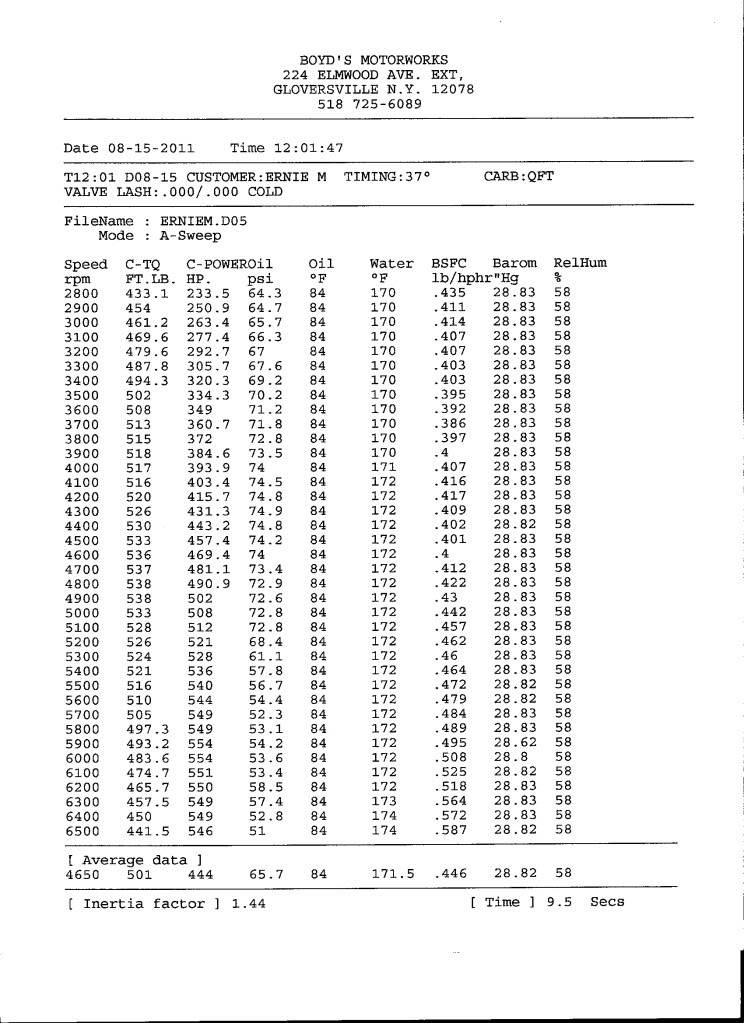What is Corrected Horsepower?
http://www.land-and-sea.com/dyno-tech-t ... epower.htm
We have all seen and made claims of an engine’s horsepower. However, this stated horsepower is almost never what the engine actually made for power. How can that be? Most of the stated horsepower numbers are “Corrected” values. The correction standards were developed to discount the observed horsepower readings taken at different locations and weather conditions. It is obvious that an engine builder in Colorado could not produce as much horsepower as a shop at sea level. There is just less oxygen for the engine to burn at the higher altitude. What are less obvious are the other weather condition effects on the engine. So in order to compensate for this all advertised horsepower is “corrected” to several different industry standards.
Most of you know about Atmospheric Correction Factors that are used to compare an engines power output for one day or location to another. However, these factors can be rather confusing and even deceptive. Everybody seems to declare there engine’s horsepower as “etched in stone” number, however we also know that the engine will make very different power on different days. Excluding other factors like engine temperature and quality of fuel used, the engine output is very dependant on the amount of oxygen in the air. So the only way to compare an engine’s horsepower is to correct the output on a given day to some standard.
The most common are the SAE standards. The older J607 standard considers that the engine was run on a 60°F day with 0% humidity and a barometric pressure of 29.92 in-Hg or the newer SAE J1349 standard of 77°F (25°C) day with 0% humidity and a barometric pressure of 29.234 in-Hg (99 KPa). Also the ECE standard is the same as the SAE J1349, but does not use mechanical efficiency in the calculations. The DIN standard which corrects to 68°F (20° C) day with 0% humidity and a barometric pressure of 29.92 in-Hg (101.3 KPa) and the JIS standard corrects 77°F (25° C) day with 0% humidity and a barometric pressure of 29.234 in-Hg (99 KPa), but uses different correction curves than the others (as a substitution for using mechanical efficiency factors). Further, we have the J1995 corrects 77°F (25° C) day with 0% humidity and a barometric pressure of 29.53 in-Hg (100 KPa).
Since very few engines are actually run in these conditions we apply these correction factors so that it is possible to compare the results taken on different days. First lets just look at the weather correction, we will see the second section dealing with mechanical efficiency later. Consider if you take a baseline run of a normally aspirated four stroke V-8 engine on a sultry day in late August, say 85°F and 85% humidity and 28.85 in-Hg and the engine produced 400 Hp. Then after you finished making all your modifications you retest the engine in late September when it is 55°F and 35% humidity and 30.10 in-Hg, the engine now makes 442 Hp. That’s almost an 11 percent increase in Hp, however the engine is actually producing the exact same amount of horsepower according to the J607 correction values of 400 Hp * 1.1005 ≈ 440 Hp and 442 * 0.994 ≈ 440 Hp. If you had retested the engine in the same weather conditions it would have made 400 Hp again.
There are many different correction “Standards” out there, but here is the SAE J1349 formula:
cf is the final correction factor multiplier
Pd is the pressure of dry air in hPa
(990 hPA = 99 kPa)
Tc is the air's temperature in degrees Celsius
One more source of confusion about the SAE J1349 is all the different values quoted for the Barometric Pressure in inches of Mercury. If you search around you will find the base values are different. Some will quote 29.234 in-Hg and others 29.318 and others 29.380. How can they all be correct? Well the calculations are done in KPa or millibars. These units are all true pressures, however inches of mercury, although considered a pressure unit, changes with temperature. This is because mercury expands as it gets warmer. Therefore 99 KPa at 32°F is 29.234 in-Hg and 99 KPa at 60°F is 29.318 in-Hg.


